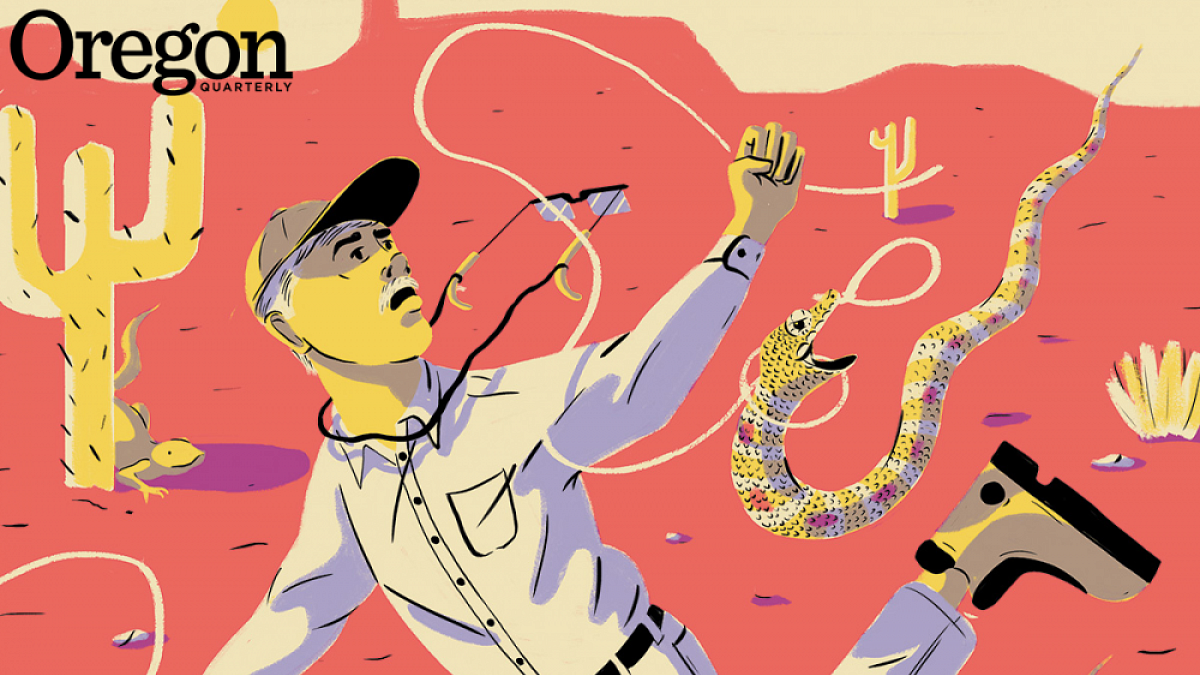Our caravan exits Highway 31 onto a two-track road that crawls into the sagebrush of Summer Lake Basin. I pull over in a prodigious dust cloud to caution the two trailing vans. “I need plenty of space—I brake for crossing reptiles.” After several shuddering miles, we park at a sandy junction with another nameless track. A leviathan ridge bouldered with dark basalt rises before us, diving southward into the gray desert sea.
Two-dozen students from my University of Oregon biology class, Amphibians and Reptiles of Oregon, pile out with pillowcases and their lizard nooses—fishing rods or dowels or bamboo sticks with a small loop of braided line knotted to the end. Gathering in a ragged circle, we talk about the various reptiles occupying rocky outcrops and the desert floor. The students squirm with eagerness, or trepidation, or both, and then spread out and dial in their inner predator—committed vegans and avid hunters alike will enthusiastically stalk a basking lizard.
Our site is a quarter-mile from Paisley Caves, a seasonal camp for humans beginning at least 14,500 years ago. People hunted Pleistocene horses and camels, and later modern mule deer, pronghorn, rabbits, and sage grouse. My aspiring herpetologists self-organize into twos and threes to pursue smaller quarry. After two decades of teaching, I’m still struck by this spontaneous eruption of a hidden tribal consciousness.
Grabbing my own gear, I head for a tongue of boulders extruded from the foot of the ridge. This is one of the snakiest places I know, and I’m not disappointed. An intense buzz erupts 10 feet away. Many years ago I was afraid of snakes, but now I move quickly toward the sound. A coiled Great Basin rattlesnake is cautioning me from beneath a four-foot sagebrush. In the broken light, the snake is partially concealed by its sandy back with dark patches. Using a walking stick retrofitted with a right-angle piece of steel, I extract the reluctant snake, gently but firmly hold the business end to the ground, and maneuver it into my bag. Despite the harassment, the snake doesn’t strike. They almost never do.
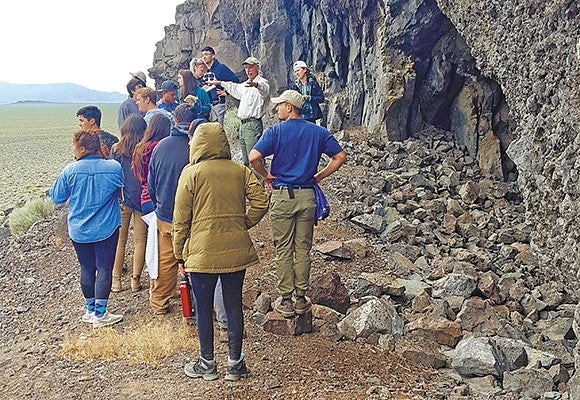
Two hours evaporate like heat shimmer. At the vans, knotted pillowcases await, strewn in the shade beneath a vehicle. The students circle around me, the bags come out, and I deliver an impromptu lecture on each captive species. From the desert floor came long-nosed leopard lizards with prominent dark spots and emery paper skin, the females sporting salmon-colored tails. They gape and display jet-black throats. I let one chomp my index finger, and suddenly several folks are begging to be bitten. Squat, round desert horned lizards have formidable but harmless spikes protruding backward from their heads. Their backs blend perfectly with brick and beige pebbles littering the desert floor. The rocks on the ridge are home to western fence lizards with prickly dark backs and blue bellies and throats that capture the furiously bright sky. Students crowd in, reaching, holding, snapping pictures, scribbling furiously in field journals. Their pressing need to see and touch and know is my addiction.
The rattlesnake is last. I ask everyone to give it a little “room to breathe,” and they happily comply. Coaxing the rattlesnake from the bag, I grasp it directly behind the skull, resting the heavy, three-foot body on the ground. This is serious show and tell. The snake’s heat-sensitive facial pits, fangs, venom, and tongue-flicking make up an integrated system for preying on small mammals. I explain that rattlesnakes have been here far longer than humans. They are our elders and deserve respect.
After an hour of interactive teaching, it’s time for the release. Everyone scatters to return the animals to where they were captured. A blanket of heat spreads over me. Suddenly I’m exhausted. But the rattlesnake is my responsibility, so I sip some tepid coffee, and then carry the serpent back to the rocks. From the open bag the snake lumbers away, disappearing into the boulders.
***
When our yearly field trips to Paisley Caves began two decades ago, I had no idea they would someday overlap with archeology. Ten years later, my class was camped at Summer Lake Hot Springs with students from the UO Archeology Field School, who were there for the modern excavation of Paisley Caves. At 7:00 a.m. their director, Senior Research Associate Dennis Jenkins, strolled among the tents belting out a vocal version of reveille. I liked him immediately. Several years after that, Dennis and I met again while my class lunched in the brittle sun at the park in nearby Paisley. Dennis offered me the chance to look at some mummified lizards excavated from the caves. We didn’t manage to reconnect.
Years passed before I finally contacted Dennis about the lizard mummies. At his lab at East Fifteenth Avenue and Moss Street, I pulled a chair up to his desk and he updated me on the Paisley Caves project. Meticulous excavation and extensive radiocarbon dating had overturned previous hypotheses regarding early tool manufacture and human occupations of western North America. Then came the shocker—one of the lizard specimens had been radiocarbon dated to about 12,200 years before the present! This late-Pleistocene date was no mistake; it was consistent with all other radiocarbon dates within the same stratum.
We moved to another room housing large plastic bins containing the Paisley Caves material. Dennis checked a handwritten catalog, rummaged through a bin, and retrieved a plastic bag containing two dust-dry, four-inch carcasses. Under magnification they were dragon-like, with sharp teeth, keeled scales, and dark patches of pigment on the belly. The preservation was extraordinary; the animals might have died last summer rather than during the Pleistocene. Their size, scales, and pigmentation identified them as sagebrush lizards, a species still found just east of Paisley Caves.
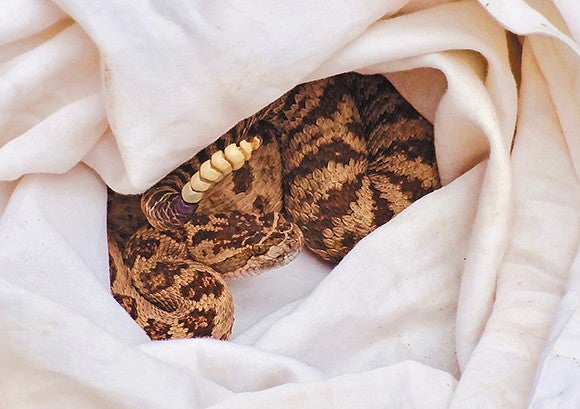
Dennis asked me what was I up to beyond teaching. I told him that my research centered on various fish genome-sequencing projects in John Postlethwait’s laboratory in the UO Institute of Neuroscience. Our conversation wandered into the challenges of sequencing ancient DNA. When an organism dies, long strands of DNA gradually degrade into shorter fragments. DNA from a 12,200-year-old sagebrush lizard would be extremely fragmented, and not much would remain. But current sequencing technology is remarkable, and our Genomics and Cell Characterization Core Facility was keeping pace. A new DNA sequencer, purchased with a gift from Mary and Tim Boyle, could register several billion short sequences in one run. Sequencing fragmented ancient DNA would be a natural application for this technology.
Dennis and I understood that DNA from the Pleistocene lizards would exist in a cocktail of sequences from other organisms, especially fungi and other microbes. Sorting this mess could best be done by matching DNA from the lizard mummies to a modern sagebrush lizard genome. I knew DNA sequencing. I knew sagebrush lizards. Dennis leaned across folded hands, blue eyes glinting.
“You want a piece of one of these lizards to see what you can do?”
My world wobbled a bit.
“You bet I do.”
The Sagebrush Lizard Genome Project was hatched.
***
The summer following my office conversation with Dennis, I returned to Summer Lake Basin to spend four weeks of writing at Playa, a nonprofit creative arts institute located directly across the valley from Paisley Caves. My Playa residency also included a bit of biology. The Sagebrush Lizard Genome Project required a critical first step: the sequencer must get DNA from the sequencee.
Sagebrush lizard DNA is sequestered inside the nuclei of cells organized into a living projectile that is four-inches long and gray with light lengthwise stripes. Even on hot afternoons, sagebrush lizards keep their body temperature within a narrow range centering around 93 degrees Fahrenheit by staying in the shade and moving only when startled. Thus, heat and sagebrush lizard hunting do not mix well.
But I like a challenge. On a hot afternoon, I pull my little pickup off Road 6184 east of Paisley Caves and shut off the engine. A prehuman silence settles in. Trees become a quaint memory. I see only sagebrush and blooms of yellow rabbitbrush, spreading in every direction, becoming an olive canvas stretched across a broad valley bounded by rim rock. This is the realm of coyotes, pronghorn, and rattlesnakes. Folks with agoraphobia should not come here.
I grab my lizard noose, which began life 50 years ago as a child’s fishing rod. Lizard noosing requires a slow sneak, then reaching with the rod to carefully slip a loop of braided line over the motionless reptile’s head, finally lifting the scrambling animal into a waiting hand. Lizards don’t appreciate this, but I’ve never injured one with a noose.
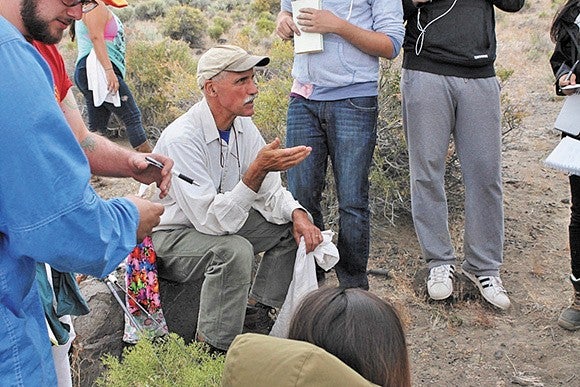
A sagebrush lizard must be met in its favorite place, and sandy soil interspersed with shrubs is ideal. When I sink into soft dirt perforated by kangaroo rat burrows, I’m in the right spot. I begin to meander. But my wandering path through the sagebrush is directed hunting, even if I’m not here with lethal intent.
After 10 minutes, that telltale gray dart pierces the space above the soil, holding motionless beneath dead stems and shadows of a large sagebrush. Twigs above the lizard’s head block the noose, but the reptile twitches forward into a space large enough for me to maneuver the loop around its neck. There is tightening, lifting, frantic scrambling—and the lizard shakes free and vanishes. My genome project remains at large.
Sometime later, another lizard squirts into a shadow, stops, and does tiny pushups. A female follows, and I realize this male is strutting his stuff. “Knock it off,” I command. It’s September, and if she were to lay a clutch of leathery eggs now, they would never hatch ahead of cold weather. The female wisely vanishes. When I slide the noose around the male, he runs through it and is gone. But maybe I’ve saved the amorous couple from a futile attempt at procreation.
My stomach tells me it’s lunchtime, so I amble back toward the pickup. A crow-size burrowing owl flaps from a sagebrush, hurtling erratically away just above the shrubs. Burrowing owls are daytime hunters, and I suspect they eat sagebrush lizards. Without malice, I blame the owl for the dearth of lizards rather than the geneticist hunting them in the heat. Returning to the pickup, I rattle farther down Road 6184, out of the owl’s territory, while devouring a warm turkey and cheese sandwich. Briefly, I’m distracted by the possibility of food poisoning.
I park at the crater of an empty waterhole surrounded by cracked hardpan and resume hunting. Soon the ground rises, the soil loosens, and I spot that speedy reptilian wisp. The sagebrush lizard stops in the shade. They always stop. But I can’t get the noose closed, and the lizard disappears. They always disappear. My swearing ripples outward into deaf barrenness. I’m tired of busting my butt for nothing but a salty forehead and better arm tan. Lizards have pea-sized brains. I’m large-brained and armed with my trusty lizard noose. I miss my class, those 25 pairs of young eyes and hands attached to youthful enthusiasm. But my solitude is intentional, designed in part to air my mind in the bright enormity of space.
I own my frustration and reconnoiter. The braided line is too heavy for small lizards. Returning to the pickup, I fashion another noose from some Reach® dental floss. Right now, Reach® seems like better branding for lizard noosing than for dental hygiene.
A thin cloud veil slides across the sun. The soil surface cools. The next lizard flushes into the open and stops. I reach with the Reach®, slide the slick noose over the lizard’s neck, and bring the scrabbling reptile into my hand. The flanks are tinged with yellow—a female.
My genome project requires a small donation of an inch of tail. Okay, so it’s extortion. I won’t fall back on the philosophically destitute phrase, “it’s for the good of science.” It’s for the good of curiosity, that strange state of mind that drove Darwin to sail on the Beagle. Besides, over the millennia predators have grabbed lizards by the tail so often that natural selection has favored features for easily parting with this appendage. Tail vertebrae of sagebrush lizards have fracture planes, allowing disconnection with little blood loss and eventual regeneration of the lost bit. To me, the biological and ethical costs seem low relative to payoffs in education and our human need to discover.
Quickly, I detach an inch of the lizard’s tail and pop it into a vial containing 95 percent ethanol. After a photograph, she is returned to her sagebrush. I salute with an outstretched hand, thanking her for her trouble.
***
Several days later, I return to Road 6184 hoping to add a few more lizard tails to the collection. I’m a teachable lizard hunter: I return in the morning, when it’s cooler. Thirteen feral horses disappear over a low ridge, Eurasian relatives of those whose Pleistocene flesh was butchered on a rock inside Paisley Caves. Another sagebrush lizard scoots and stops, seemingly waiting to be captured. I comply, and the end of her tail becomes a backup copy for the genome project. But after two more hours of crisscrossing the sandy steppe, no more lizards flash across my path. A diminutive breeze stirs the expanding heat, pushing the sun southwest across limitless blue. The hunter within tells me the sagebrush lizards of Road 6184 have given enough.
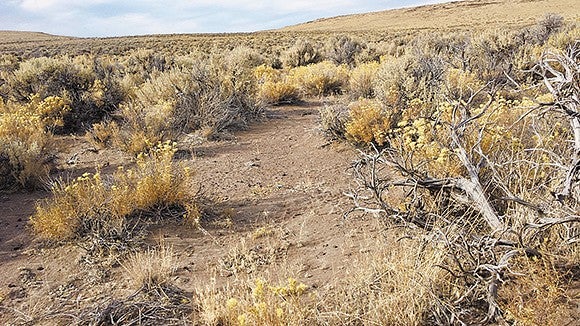
At the pickup, I change into running shoes, shorts, and mesh shirt, don a small hydration backpack, and begin jogging along a rough vehicle track rising toward the skyline that swallowed the horses. Near the top the road peters out, but I dodge onward through openings in the scrub. The sun becomes a furrowed brow of heat behind me, the dark bicep of Diablo Mountain bulges to my left. The soil is soft, the going slow. I don’t care.
My improvised path bisects another road that wanders into a shallow basin, ending at a pond of thick brown water. The surrounding mud is inscribed with thirsty stories of horses and pronghorn. Emptiness engulfs me, and I stop to stuff my shorts and shirt into the pack. Wearing only shoes and hat, I jog onward following small gullies carved in sand. My sweat evaporates quickly in the dry heat, forming cool patches in unfamiliar places. Looking up, I spot the horses watching from a low ridge. They understand. Like me, they know this country in the marrow and mineral of their bones, but are descended from transplants with no direct ancestry here.
My own reptilian rhythm deepens. Layers of space loosen, swallowing the soft rasp of my breathing. My mind wanders into the deep maw of time, and I descend from the bleeding edge of genome sequencing through 20 tribes of students and 50,000 generations of human consciousness permeating this immensity. When I resurface, there is only my sweating body, still panting, still plodding across the withered earth.
—By Tom Titus
Tom Titus is a senior research associate in the UO Institute of Neuroscience, a herpetologist, and author of Blackberries in July: A Forager’s Field Guide to Inner Peace. The tail of the sagebrush lizard of Road 6184 awaits DNA sequencing in the Genomics and Cell Characterization Core Facility.


